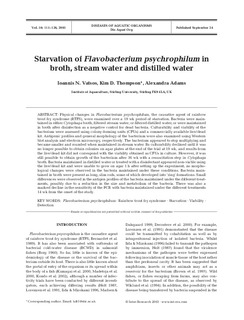| dc.contributor.author | Vatsos, Ioannis N. | |
| dc.contributor.author | Thompson, Kim D. | |
| dc.contributor.author | Adams, Alexandra | |
| dc.date.accessioned | 2015-08-10T10:37:48Z | |
| dc.date.accessioned | 2015-08-11T06:23:17Z | |
| dc.date.available | 2015-08-10T10:37:48Z | |
| dc.date.available | 2015-08-11T06:23:17Z | |
| dc.date.issued | 2003 | |
| dc.identifier.citation | Vatsos, I.N., Thompson, K.D. & Adams, A. (2003). Starvation of Flavobacterium psychrophilum in broth, stream water and distilled water. Diseases of Aquatic Organisms, 56(2), 115-126. doi: | nb_NO |
| dc.identifier.issn | 1616-1580 | |
| dc.identifier.uri | http://hdl.handle.net/11250/295881 | |
| dc.description.abstract | Physical changes in Flavobacterium psychrophilum, the causative agent of rainbow trout fry syndrome (RTFS), were examined over a 19 wk period of starvation. Bacteria were maintained in either Cytophaga broth, filtered stream water, or filtered distilled water, or were maintained in broth after disinfection as a negative control for dead bacteria. Culturability and viability of the bacterium were assessed using colony-forming units (CFUs) and a commercially available live/dead kit. Antigenic profiles and general morphology of the bacterium were also examined using Western blot analysis and electron microscopy, respectively. The bacterium appeared to stop multiplying and became smaller and rounded when maintained in stream water. Its culturability declined until it was no longer possible to obtain colonies on agar plates at the end of the trial at 19 wk, and results from the live/dead kit did not correspond with the viability obtained as CFUs in culture. However, it was still possible to obtain growth of the bacterium after 36 wk with a resuscitation step in Cytophaga broth. Bacteria maintained in distilled water or treated with a disinfectant appeared non-viable using the live/dead kit and were unable to grow on agar 1 h after setting up the experiment; no morphological changes were observed in the bacteria maintained under these conditions. Bacteria maintained in broth were present as long, slim rods, some of which developed into Œring¹ formations. Small differences were observed in the antigen profiles of the bacteria maintained under the different treatments, possibly due to a reduction in the size and metabolism of the bacteria. There was also a marked decline in the sensitivity of the PCR with bacteria maintained under the different treatments 14 wk from the onset of the study. | nb_NO |
| dc.language.iso | eng | nb_NO |
| dc.publisher | Inter-Research | nb_NO |
| dc.rights | Navngivelse 3.0 Norge | * |
| dc.rights.uri | http://creativecommons.org/licenses/by/3.0/no/ | * |
| dc.title | Starvation of Flavobacterium psychrophilum in broth, stream water and distilled water | nb_NO |
| dc.type | Journal article | nb_NO |
| dc.type | Peer reviewed | nb_NO |
| dc.date.updated | 2015-08-10T10:37:48Z | |
| dc.rights.holder | © 2003, Inter-Research | |
| dc.subject.nsi | VDP::Agriculture and fishery disciplines: 900::Fisheries science: 920::Fish health: 923 | nb_NO |
| dc.source.pagenumber | 115-126 | nb_NO |
| dc.source.volume | 56 | nb_NO |
| dc.source.journal | Diseases of Aquatic Organisms | nb_NO |
| dc.source.issue | 2 | nb_NO |
| dc.identifier.doi | 10.3354/dao056115 | |
| dc.identifier.cristin | 1213240 | |

